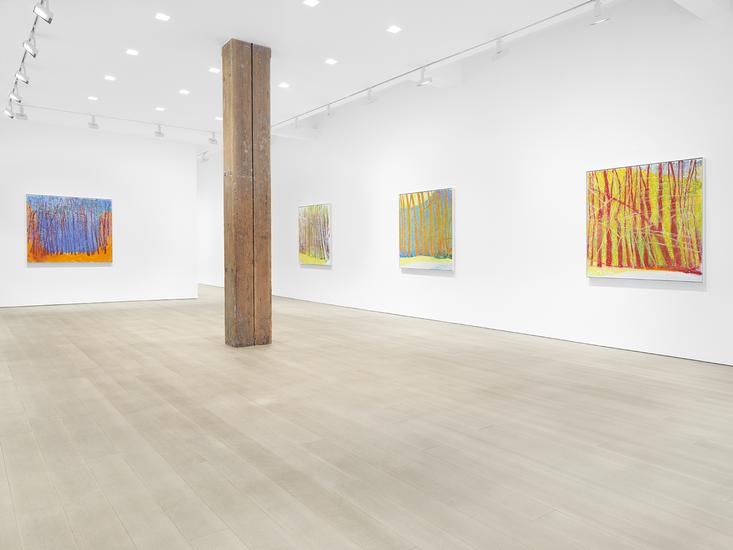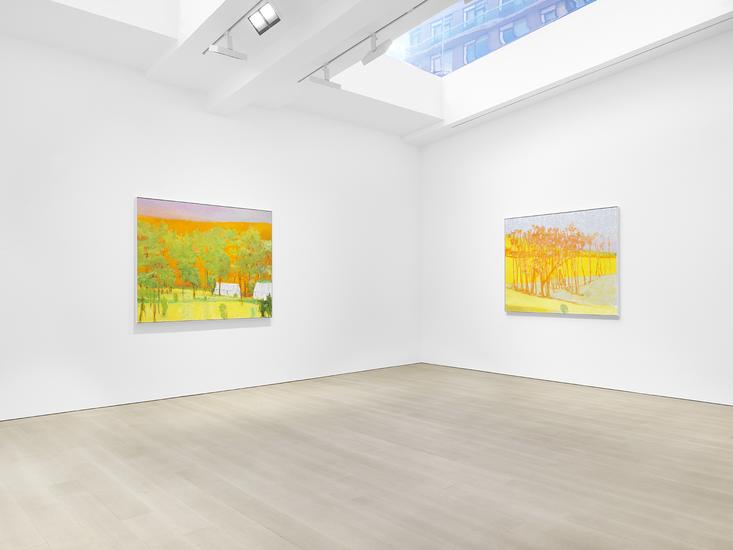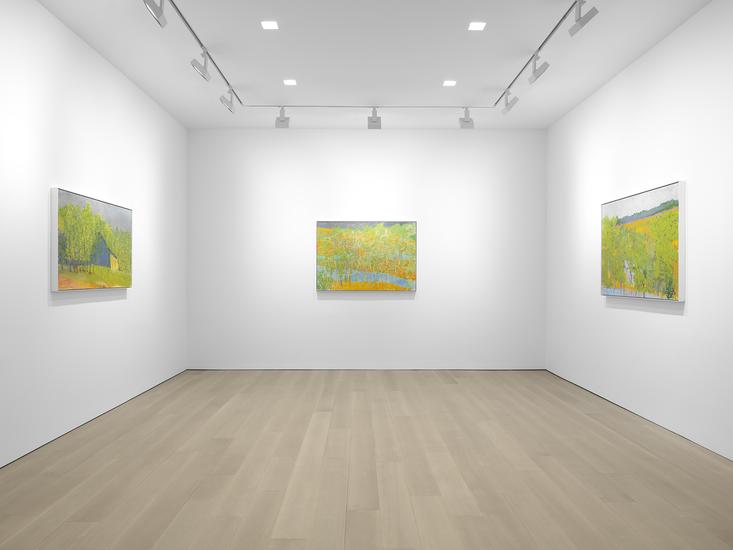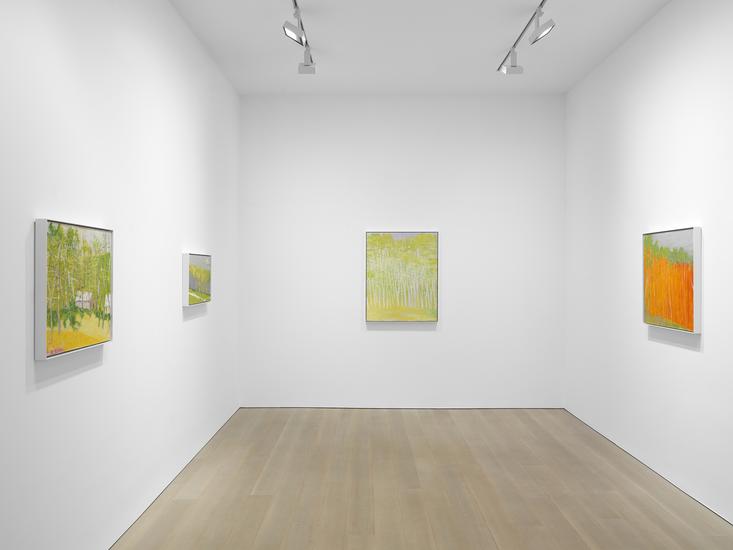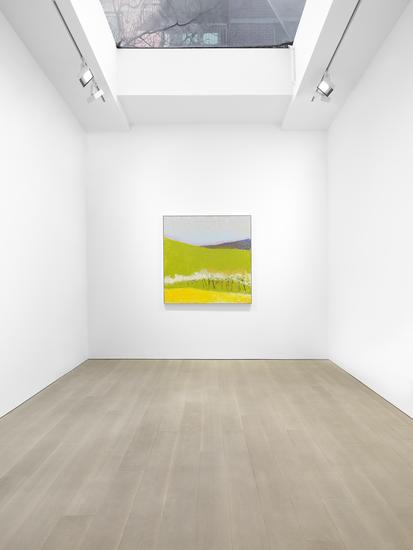NEW YORK, NEW YORK – MILES McENERY GALLERY is pleased to announce an exhibition by Wolf Kahn. The Last Decade: 2010 - 2020 will open on 7 January at 525 West 22nd Street and will remain on view through 13 February 2021. The exhibition is accompanied by a fully illustrated publication featuring an essay by Assistant Professor Alex J. Taylor.
Wolf Kahn: The Last Decade 2010 - 2020
7 January - 13 February 2021
BackPress Release
Looking at paintings from the final decade of Wolf Kahn’s life, it is easy to find an aesthetic pleasure that makes it effortless to focus on the relations of color and form. While these relationships are carefully ordered, for Kahn they are never merely restful. The paintings’ vivid color palettes are engaged by the experiences and sensations of the natural world. Kahn’s landscapes are also connected to a social imagination. “I want people to participate freely in my paintings...to connect my paintings as directly as possible to their surroundings,” he explained in a 1988 interview.
Kahn had the ability to reject the more rigid structures of the modernist avant-garde, but he also remained committed to its ambition, as he once put, to “show the world something it has never seen before.” He was also particularly attentive to the sense of scale and the bodily relation achieved by the most ambitious forms of post-war abstraction. To this end, he once explained that the repetitive verticals in his works relate not simply to the form of the tree trunks they describe, but also to the artist’s own body, because “the arm moves naturally up and down.”
By reveling in the sensorial effects of nature but also defamiliarizing its conventions through modernist form and color, Kahn’s landscapes achieve a distinctive blend of affect and analytical rigor. The paintings are above all resolutely ordinary landscapes elevated by virtue of the artist’s intervention—slices of American history devoid of famous names and dates, but immortalized by his close attention.
Alex J. Taylor remarks, “Kahn’s paintings reveal forceful archetypes of the American landscape in its neglected corners, quiet tributes to the untold stories of unseen occupants, past and present. In so doing, his paintings remind us of our own manifold connections to the land—even those of us for whom it is seen mainly from the window of a car or a train, or indeed on the wall of a Manhattan gallery.”
WOLF KAHN (1928 - 2020) was born in Stuttgart, Germany in 1928. He emigrated to the United States by way of England in 1940. In 1945, he graduated from the High School of Music & Art in New York, after which he spent time in the Navy. Under the GI Bill, he studied with renowned teacher and Abstract Expressionist painter Hans Hofmann, later becoming Hofmann’s studio assistant. In 1950, he enrolled in the University of Chicago. He graduated in 1951 with a Bachelor of Arts degree.
After completing his degree in only one year, Kahn decided to return to being a full-time artist. He and other former Hofmann students established the Hansa Gallery, a cooperative gallery where Kahn had his first solo exhibition. In 1956, he joined the Grace Borgenicht Gallery, where he exhibited regularly until 1995.
Traveling extensively, he has painted landscapes in Egypt, Greece, Hawaii, Italy, Kenya, Maine, Mexico, and New Mexico. He spent his summers and autumns in Vermont on a hillside farm, which he and his wife, the painter Emily Mason, owned since 1968. However, his primary residence was in New York City. Kahn and Mason have two daughters, Cecily and Melany. Cecily Kahn is also an artist, and is married to the painter David Kapp.
The unique blend of Realism and formal discipline of Color Field painting sets the work of Wolf Kahn apart. Kahn is an artist who embodies a synthesis of artistic traits – the modern abstract training of Hans Hofmann, the palette of Matisse, Rothko’s sweeping bands of color, and the atmospheric qualities of American Impressionism.
Wolf Kahn regularly exhibited at galleries and museums across North America. His work may be found in the collections of The Metropolitan Museum of Art, New York, NY; The Whitney Museum of American Art, New York, NY; The Museum of Modern Art, New York, NY; The Museum of Fine Arts, Boston, MA; The Hirshhorn Museum, The Smithsonian American Art Museum,Washington, D.C.; The Los Angeles County Museum of Art, Los Angeles, CA; The Arkansas Arts Center, Little Rock, AR; The Arts Club of Chicago, Chicago, IL; The Asheville Art Museum, Asheville, NC; The Brooklyn Museum, Brooklyn, NY, The Columbus Museum of Art, Columbus, OH; The Dallas Museum of Art, Dallas, TX; The El Paso Museum of Art, El Paso, TX; The Heckscher Museum, Huntington, NY; Hickory Museum of Art, Hickory, NC; The Kemper Museum of Contemporary Art, Kansas City, MO; The Lincoln Nebraska Art Association, Lincoln, NB; The Milwaukee Art Museum, Milwaukee, MN; The Minnesota Museum of American Art, St. Paul, MN; The Mint Museum of Art, Charlotte, NC; The Museum of Fine Arts, Houston, TX; The National Academy of Design, New York, NY; The New Jersey Center for Visual Arts, Summit, New Jersey; The National Museum of American Art, Washington, DC; The New Orleans Museum of Art, New Orleans, LA; The Saint Louis Art Museum, St. Louis, MO; The San Diego Museum of Art, San Diego, CA; The Springfield Museum of Fine Arts, Springfield, MA; The Virginia Museum of Fine Arts, Richmond, VA; and the Worcester Art Museum, Worcester, MA.
Kahn has received a Fulbright Scholarship, a John Simon Guggenheim Fellowship, an Award in Art from the Academy of Arts and Letters, a Lifetime Achievement Award from the Vermont Council of the Arts, and a Medal of Arts from the U.S. State Department.
He was elected to membership of the National Board of the College Art Association, elected to the board of the National Academy of Design, and elected to membership of the American Academy and Institute of Arts & Letters.
Kahn died in 2020 in New York, at the age of 92.

